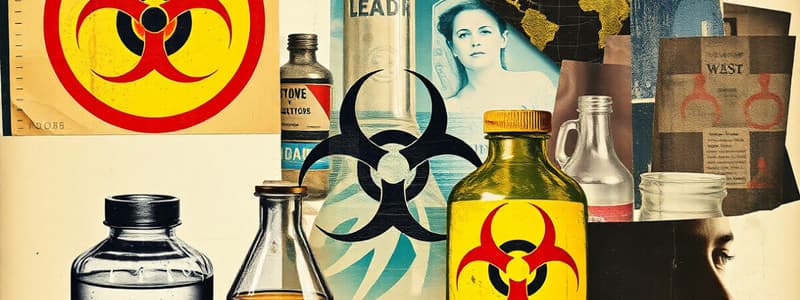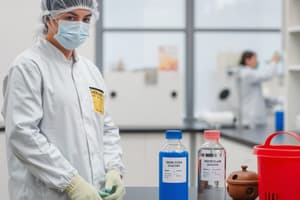Podcast
Questions and Answers
What color bag is typically used for biohazard waste?
What color bag is typically used for biohazard waste?
- Green
- Red
- Blue
- Yellow (correct)
Which of the following is considered biohazard waste?
Which of the following is considered biohazard waste?
- Glass beakers
- Used PPE (correct)
- Paper towels
- Plastic containers
Where are sharps typically collected in a laboratory?
Where are sharps typically collected in a laboratory?
- Recycling bins
- Cardboard boxes
- Yellow bench-top bins (correct)
- Regular trash cans
Which of these items is considered a sharp?
Which of these items is considered a sharp?
What is a common procedure for disposing of solvents and harmful reagents?
What is a common procedure for disposing of solvents and harmful reagents?
What type of waste includes paper and plastic ware?
What type of waste includes paper and plastic ware?
Which of the following is NOT typically considered chemical waste?
Which of the following is NOT typically considered chemical waste?
What should be done with a broken glass beaker that is not contaminated with biohazardous material?
What should be done with a broken glass beaker that is not contaminated with biohazardous material?
Why is proper waste segregation important in a laboratory?
Why is proper waste segregation important in a laboratory?
What is the main purpose of using a fume hood when disposing of chemical waste?
What is the main purpose of using a fume hood when disposing of chemical waste?
Which of the following wastes does NOT require any special handling or disposal?
Which of the following wastes does NOT require any special handling or disposal?
In the context of waste disposal, what does 'segregation' refer to?
In the context of waste disposal, what does 'segregation' refer to?
What is the primary function of the biohazard symbol on waste bags?
What is the primary function of the biohazard symbol on waste bags?
What is the immediate next step after a needle stick injury?
What is the immediate next step after a needle stick injury?
Which container is usually used to collect used glass pipettes?
Which container is usually used to collect used glass pipettes?
What does a 'winchester' bottle typically contain within a laboratory setting?
What does a 'winchester' bottle typically contain within a laboratory setting?
What is the risk of not properly disposing of chemical waste?
What is the risk of not properly disposing of chemical waste?
In the event of a chemical spill, what should you do first?
In the event of a chemical spill, what should you do first?
What is a common mistake in disposing of laboratory waste?
What is a common mistake in disposing of laboratory waste?
Are gloves considered General Waste after usage?
Are gloves considered General Waste after usage?
Flashcards
Biohazard Waste
Biohazard Waste
Waste including utensils, containers, tissue paper, and sample material, usually collected in yellow biohazard bags.
Sharps Waste
Sharps Waste
Waste including needles, scalpel blades, and broken glass, collected in yellow bench-top bins.
Chemical Waste
Chemical Waste
Waste including reagents, reaction products, and solvents, often decanted into labeled bottles within a fume hood.
General Waste
General Waste
Signup and view all the flashcards
Study Notes
- Waste generated in the lab must be carefully disposed of.
Biohazard Waste
- Biohazard waste includes utensils, containers, tissue paper, and also sample material.
- It is collected in strong, yellow bags marked with the biohazard symbol.
Sharps
- Sharps waste includes hypodermic syringe needles, scalpel blades, glass capillary pipettes, microscope slides, and any other equipment used in the laboratory labelled as sharp.
- This waste is usually collected in yellow bench-top bins.
Chemical Waste
- Chemical waste includes reagents, reaction products, laboratory-prepared solutions, and solvents.
- Solvents and other harmful reagents are decanted into "winchester" bottles within a fume hood for disposal.
General Waste
- General waste includes paper, containers, plastic ware, and other non-hazardous waste.
Studying That Suits You
Use AI to generate personalized quizzes and flashcards to suit your learning preferences.



